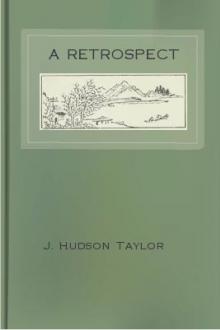Court Life in China, Isaac Taylor Headland [an ebook reader .txt] 📗

- Author: Isaac Taylor Headland
- Performer: -
Book online «Court Life in China, Isaac Taylor Headland [an ebook reader .txt] 📗». Author Isaac Taylor Headland
The Funeral Ceremonies of a Dowager Princess
There are five degrees of mourning, as follows:—For parents, grandparents and great-grandparents; for brothers and sisters; for uncles and aunts; and for distant relatives. In the first sackcloth without hem or border; in the second with hem or border; in the third, fourth and fifth, pieces of sackcloth on parts of the dress. When sackcloth is worn, after the third interval of seven days is over the mourners can cast it off, and wear plain colours, such as white, gray, black and blue. For a parent the period is nominally three years, but really twenty-seven months, during all which time no silk can be worn; during this time officials have to resign their appointments, and retire from public life. —Dyer Ball in “Things Chinese.”
XVIIITHE FUNERAL CEREMONIES OF A DOWAGER PRINCESS[5]
[5] Taken from Mrs. Headland’s note-book.
One day I received a large sheet of white paper on which was written in Chinese characters the announcement of the death of the Dowager Princess Su, and inviting me to the “third-day exercises.” The real meaning of this “chieh san” I did not comprehend, but I knew that those who were invited sent presents of cakes or fruit, or baskets of paper flowers, incense, gold and silver ingots made of paper, or rolls of paper silk, all of which were intended for the use of the spirit of the departed. The paper presents were all burned on the evening of the third day, while the spirit feasted upon the flavour of the fruit and cakes.
As I did not feel that it was appropriate for me to send these things, I had a beautiful wreath of white chrysanthemum flowers made, and sent that instead. While I appreciated the invitation, I thought it was probably given only as a matter of form, and that I was not expected to attend the exercises, and so I sent my Chinese maid with the wreath, saying that as I did not understand their customs I would not go.
It was not long until the maid returned saying that they were anxious to have me come, that under no circumstances must I refuse, as they wished me to see their funeral ceremonies. The Princess sent her cart for me, and according to the Chinese custom, I took my maid seated upon the front, and set out for Prince Su’s palace. As we neared our destination we passed numerous carts and chairs of princes who had been at the palace to pay their respects. The street leading off the great thoroughfare was filled with carts, chairs, servants and outriders, but the utmost order prevailed. There were scores of soldiers and special police, the latter dressed in long garments of gray with a short jacket of white on the breast of which was his number in black. These gray and white uniforms were mourning colours, and were given by the Prince.
As we entered the gate we saw white-robed servants everywhere, each with a sober face and a dignified bearing, waiting to be of use. My name was announced and two servants stepped out from the crowd, clothed from head to feet in white sackcloth, one presenting his arm to help me through the court, as though I were a bound-footed woman, and the other led the way. We were taken by a roundabout path, through numerous courts and passages, the front being reserved for the male guests, and were finally ushered into a room filled with white-robed women servants, who with one accord bent their knee in a low courtesy.
We were there met by the first and third Princesses, daughters of the Dowager who had just passed away. They were dressed in white, their hair being put up in the Manchu fashion. Instead of the jewels and bright flowers, however, it was crossed and recrossed with bands of white folded sackcloth. As these two ladies were married daughters, and had left this home, their sackcloth was not so coarse as that of the daughters-in-law and granddaughters who dwelt in the palace. It was they who received the guests and conducted them into the room where the mourners were kneeling.
As the white door screen was raised I saw two rows of white-robed figures kneeling on the floor, and as I entered they all bent forward and touched their head to the ground, giving forth as they did it a low, wailing chant.
Not knowing their customs I went up and stooped over, speaking first to the Princess and then to the ladies as best I could. I afterwards watched the other lady visitors and saw that they put their right hand up near their head as our soldiers salute, and courtesied to the Princess, her daughter-in-law and her eldest daughter. They then went over to a little table on which was a silver sacrificial set, consisting of a wine tankard, a great bowl, and a number of tiny cups holding but two tablespoonfuls. They took the cup in its little saucer, and, facing the beautiful canopied catafalque where the Dowager Princess was lying in state, they raised the cup as high as their head three times, emptying and refilling it each time. The mourners prostrated themselves and gave forth a mournful wail each time the cup was poured, after which the visitor arose and came over to where we were, and the ceremony was over.
The third daughter of the late Dowager seemed to regard me as her special friend and guest, and insisted on my coming over to a white curtain that separated us from the view of the gentlemen, and from there I watched the proceedings of princes and officials who went through a similar ceremony. There was this difference with them, however, as they entered through the great canopied court, they were conducted by white-robed servants directly to the altar, and there kneeling, they made their obeisance to the spirit of the departed, after which they went into the room where the Prince and the other male descendants of the dead Dowager were kneeling and prostrating themselves.
There was a heavy yellow curtain over the door that led into the sacrificial hall, and when the servants from without announced a visitor, this curtain was drawn aside, and as the guest and a flood of light entered, the mourners began their wailing which they continued until he had departed. These visitors remained but a moment, while the ladies who were there were all near relatives, and were dressed either entirely or partially in sackcloth.
The room in which these ladies knelt was draped in white. The cushions were all covered with white, and all porcelain and other decorations had been removed. The floor was covered with a heavy rope matting, on which the ladies knelt—all except the Princess, for whom was prepared a small dark blue felt cushion. The Princess knelt at the northwest corner of the room, directly in front of the curtain which separated them from the sacrificial hall. Several of the very near male relatives entered and gave the low Manchu courtesy to the Princess, the son’s wife, and the eldest daughter, though none of the other kneeling ladies were recognized. They left immediately without, so far as I noticed, raising their eyes.
The Prince, his sons and the other mourners in the men’s room were clothed in white fur, and the servants too, who stood in the sacrificial hall, and at intervals along the way towards the hall, wore white fur coats instead of sackcloth.
To the left of the Princess there knelt in succession all the secondary wives of Prince Su, and if I mistake not there were five of these concubines. Behind the Princess knelt her son’s wife—the future Princess Su, and on her left, the daughters and granddaughters of the Prince knelt in succession. The Princess and secondary princesses had bands of sackcloth wound around their heads, though their hair hung down their backs in two long braids, and as I had never seen these princesses except when clothed in beautifully embroidered satin garments, with hair put up in elaborate coiffures, decked with jewels and flowers, and faces painted and powdered in the proper Manchu fashion, it was not easy to recognize them in these white-robed, yellow-faced women, with hair hanging down their backs.
The grandson’s wife and granddaughters, on the other hand, had their hair combed, but the long hairpin was of silver instead of jade or gold, and instead of being decorated with jewels and flowers, and a red cord, it was crossed and recrossed with bands of folded sackcloth an inch and a half in width. It was neat and very effective—the black hair and white cloth making a pretty contrast to the Western eye, though it would probably not be so considered by the Chinese.
After I had watched them for a few moments I said to the princess who accompanied me:
“I must not intrude upon your time longer; you have been very kind to allow me to witness all these interesting customs.”
“Oh, but you must not go now,” she insisted; “you must remain and see the arrival of the priests, and the burning of the paper houses, goods, chattels, and images on the great street. I want you to understand all our customs, and this is the greatest and most interesting day of the funeral ceremonies.”
I urged that I ought not to intrude myself upon them at this time.
“No, no,” she said, “you must not say that. It is not intrusion; you must stay and dine with us this evening.”
When I still insisted upon going she said that if I went they would feel that I did not care for them, and she was so persistent that I consented to remain if the maid might be sent home to the children, which they at once arranged for.
In the interval between the arrival of male guests, the ladies took me out into a large canopied court to see the decorations, and into the sacrificial hall. These ceremonies were all conducted in the house and court which the Dowager Princess had occupied, and where I had often gone to see her when she wanted to thank me for some medical attention I had given her children or grandchildren.
As we passed through the great gate, I noticed that the court was covered with a mat pavilion making a room about one hundred and fifty feet square, lighted by great squares of glass near the top, and decorated with banners of rich brocade silks or satins, of sober colours, blue, gray or white, on which were texts extolling the virtues of the late Dowager or her family. These were the gifts of friends, who had been coming and would continue to come for days if not weeks.
At the north end as one came in at the gate was a gallery running the whole length of the northern court, fitted up with special hangings which separated it into different compartments. Many elegant banners and decorations gave it a striking effect. This was the place where the priests, who had not yet arrived, were to say their prayers day and night until the funeral ceremonies were over.
Directly in front of the catafalque, in the gallery, there was a table on which I afterwards saw the priests place a silver vessel which the head priest carried, and the others regarded with much solemnity.
From the gateway leading into the sacrificial hall the floor of the court had been raised even with the door of the house and the gate, a height of about five feet, and forty feet wide, and was covered





Comments (0)